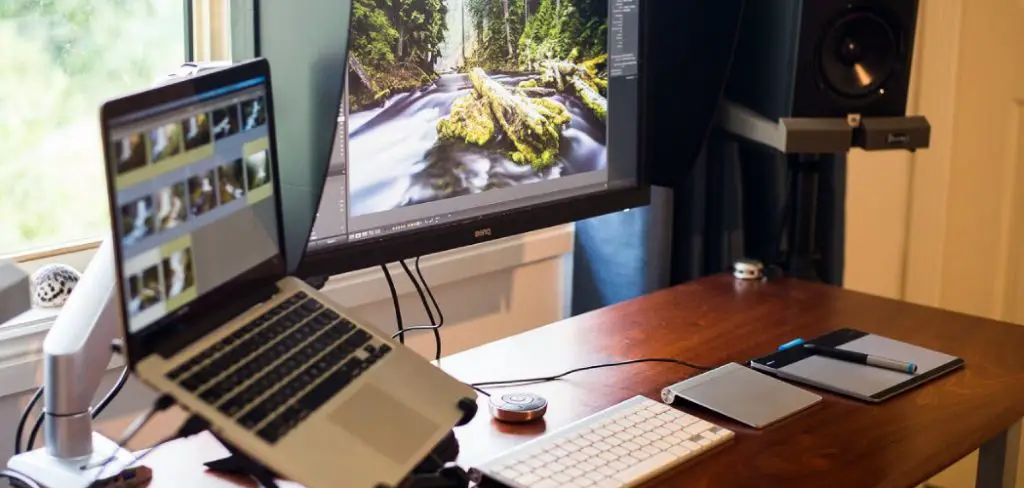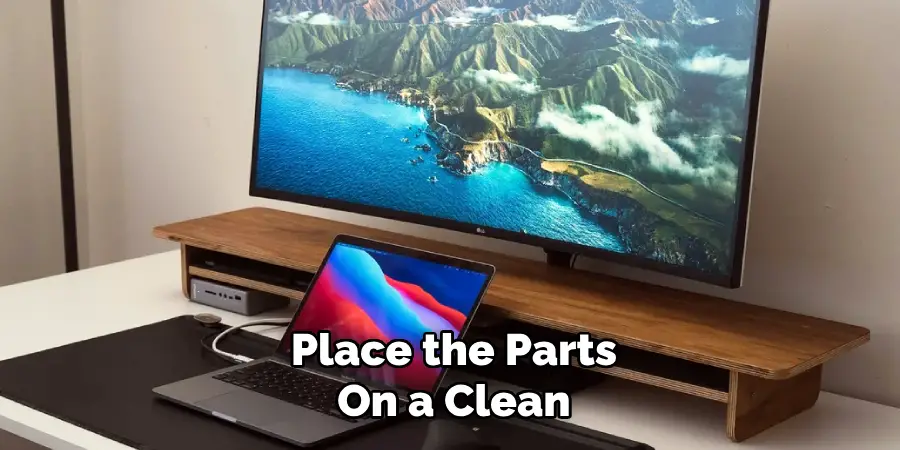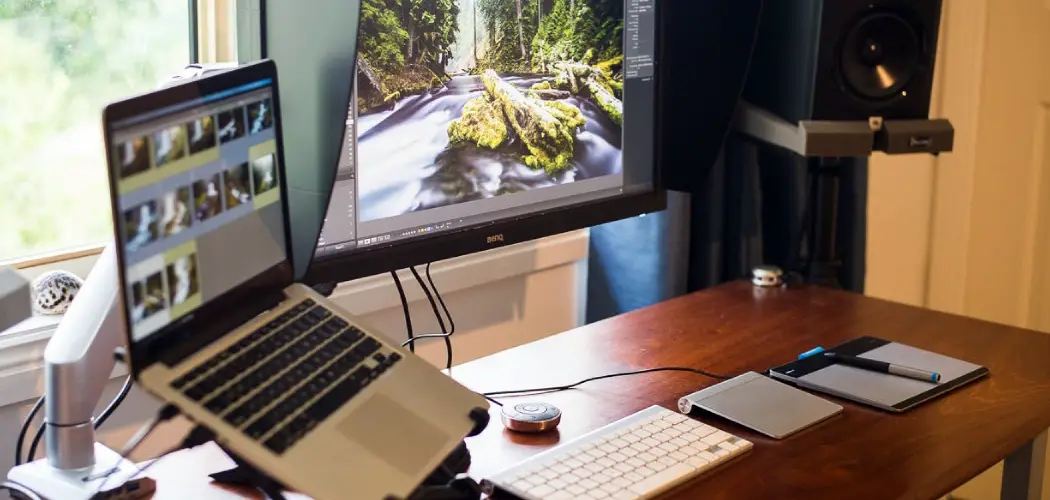Are you tired of a cluttered desk with an uncomfortable viewing experience? Look no further. The Gianotter Desk Computer Monitor Stand is here to solve all your problems. This innovative stand allows you to elevate your computer monitor for a more ergonomic setup while providing storage space and organization for your desk.

The Gianotter Desk Computer Monitor Stand is designed to enhance your workspace by elevating your monitor to an optimal viewing height, reducing neck and eye strain while promoting better posture. This versatile and sturdy stand improves ergonomics and helps maximize desk space with its convenient storage design.
In this guide on how to use gianotter desk computer monitor stand, we’ll go through the step-by-step instructions to set up and use this stand effectively.
What Will You Need?
Before you start setting up the stand, make sure you have the following items:
- Gianotter Desk Computer Monitor Stand: you’ll need the stand itself. It comes with all the necessary hardware for assembly.
- Screwdriver: a Phillips head screwdriver will be required to tighten the screws during assembly.
- Monitor or Laptop: whichever device you use with the stand, make sure it is compatible and within the weight limit.
Once you have these items, you can start setting up your Gianotter Desk Computer Monitor Stand.
10 Easy Steps on How to Use Gianotter Desk Computer Monitor Stand
Step 1. Unbox the Stand:

Carefully open the packaging of the Gianotter Desk Computer Monitor Stand. Make sure to remove all components, including the main stand, screws, and any additional hardware included in the box. Check that all the parts listed in the instruction manual are present. If anything seems to be missing, refer to the manufacturer’s contact information for support. Place the parts on a clean, flat surface to ensure nothing gets misplaced during assembly. Be cautious when handling the pieces to avoid scratching or damaging them.
Step 2: Assemble the Stand:
Begin by identifying the main frame of the monitor stand as indicated in the instruction manual. Locate the necessary screws and tools included in the package, or use your tools if required. Align the base of the stand with the designated attachment points on the frame. Carefully insert and hand-tighten the screws into place to ensure everything aligns properly before fully securing them with a screwdriver.
Ensure the stand is stable and level during this process to avoid assembly errors. If your monitor stand includes adjustable or modular parts, follow the instructions to attach those components securely. Ensure each connection point is firm to prevent wobbling or instability once the monitor is mounted. Double-check your work and confirm that all screws are tightened appropriately, but avoid over-tightening as this may damage the components.
Step 3: Attach the Phone Holder:
To attach the phone holder, locate the designated attachment point on the monitor stand or the specified area in the assembly instructions. The phone holder might use a clamp mechanism, screws, or a magnetic attachment, depending on the design. Begin by aligning the phone holder’s base or attachment mechanism with the connection point.
If the holder uses screws, insert and hand-tighten them to ensure proper placement before entirely securing them with a screwdriver. For clamp-based holders, gently adjust the clamp to fit snugly around the designated area without overtightening, which could cause damage. If the holder uses a magnetic connection, ensure the magnetic surface is clean and free from dust or debris to allow for a secure attachment. Once attached, test the holder’s stability by gently placing your phone and adjusting its position to confirm it remains firm and level.

Step 4: Adjust Height Settings:
Properly adjusting the height settings of your monitor stand is vital for ergonomics and overall comfort during use. Start by identifying the adjustment mechanism on the stand, which is often a lever, knob, or sliding system, depending on the model. Carefully loosen the adjustment mechanism to allow the stand to move freely.
Gradually raise the monitor stand to match your eye level when seated in your usual position. The top of the screen should be at or slightly below eye level to reduce strain on your neck and shoulders. Once the desired height is achieved, secure the adjustment mechanism to lock the stand, ensuring it is stable and does not shift during use. If your monitor stand supports incremental height adjustments, test different positions to determine what works best for your posture. Additionally, check that the monitor remains tilted slightly upward, which optimizes viewing comfort. Regularly reassess and readjust the height settings, significantly if you change chairs, desks, or your seating position.
Step 4: Adjust the Monitor’s Distance and Angle
Position the monitor at an appropriate distance to avoid straining your eyes. The ideal distance is typically between 20 to 30 inches from your eyes or about an arm’s length away. This ensures that the text on the screen is easily readable without leaning forward or backward. Adjust the monitor’s tilt to reduce glare and enhance visibility; a slight backward tilt is usually most effective.
Be mindful of reflections from windows or lighting, as these can impact screen visibility. Make incremental adjustments if necessary to achieve a comfortable viewing angle and distance. Regularly revisit these settings to account for changes in your work environment or vision needs.
Step 5: Organize Your Workspace
A well-organized workspace can significantly improve both productivity and comfort. Arrange your desk essentials, such as your keyboard, mouse, and other accessories, so that they are within easy reach without causing unnecessary strain. Keep frequently used items close by to avoid repetitive stretching or awkward movements. Ensure that your workspace is free of clutter to maintain focus and reduce distractions. Position additional tools like a document stand or a secondary screen at appropriate angles and heights for seamless interaction. Periodically reassess your workspace organization to ensure it aligns with your daily workflow and ergonomic needs.
Step 6: Take Regular Breaks

You must incorporate regular breaks into your routine to maintain both physical and mental well-being. Prolonged periods of sitting or repetitive tasks can lead to fatigue, muscle tension, and decreased productivity. Aim to take short breaks every 30 to 60 minutes, during which you can stand, stretch, or walk around to promote circulation and relieve stiffness. Additionally, consider practicing the 20-20-20 rule for eye health—every 20 minutes, look at something 20 feet away for at least 20 seconds. These brief pauses help refresh your body and mind, allowing you to return to work with renewed focus and energy.
Step 7: Stay Hydrated and Eat Nutritious Meals
Proper hydration and nutrition play a crucial role in maintaining focus and overall productivity throughout the day. Keep a water bottle nearby and aim to drink enough water to stay hydrated, especially during long working hours. Additionally, prioritize balanced meals and healthy snacks that provide sustained energy, such as fruits, nuts, or whole grains. Avoid excessive consumption of sugary or highly processed foods, as they can lead to energy crashes and reduced concentration. By fueling your body with the proper nutrients, you support your physical and mental performance.
Step 8: Create a Dedicated Workspace
A dedicated workspace helps establish clear boundaries between work and relaxation, enhancing focus and productivity. Ensure your workspace is comfortable, organized, and free from distractions. Invest in ergonomic furniture, such as a supportive chair and an adjustable desk, to maintain good posture and reduce physical strain. Personalize your space with elements that inspire you, like plants, artwork, or motivational quotes, but keep clutter to a minimum. Having a designated area for work signals to your brain that it’s time to concentrate, making it easier to stay on task.
Step 9: Take Regular Breaks
Taking regular breaks is crucial for maintaining productivity and preventing burnout. Short pauses during work sessions allow your mind to rest, recharge, and refocus. Consider using time management techniques, such as the Pomodoro Technique, which involves 25-minute focused work intervals followed by 5-minute breaks. During your breaks, engage in activities that refresh you, such as stretching, walking, or deep breathing exercises. Longer breaks, such as a lunch break, allow you to step away entirely, re-energizing your mind and body for the rest of the day. Remember, consistent breaks enhance your performance and support overall well-being.
Step 10: Review and Reflect on Your Progress

At the end of each day, take a few moments to review and reflect on your accomplishments. Assess what tasks you completed, challenges you encountered, and how you can improve moving forward. This practice reinforces a sense of achievement and helps you identify patterns or areas that may need adjustment. Keeping a journal or to-do list can help track your progress and plan future goals. Reflection fosters growth and ensures that you stay aligned with your priorities, leading to continuous improvement in your productivity and overall success.
By following these steps and implementing healthy work habits, you can create a more ergonomic and efficient workspace that supports your productivity, well-being, and success.
Conclusion
How to use gianotter desk computer monitor stand is a simple yet effective way to enhance your workspace ergonomics and organization.
Begin by placing the stand on a stable and flat surface, ensuring it is positioned securely. Adjust the placement of your monitor on the stand so the screen is at eye level, helping to reduce strain on your neck and shoulders. The stand’s elevated design allows for additional storage space, enabling you to declutter your desk by storing items like keyboards, notebooks, or office supplies. Regularly review your workspace setup to ensure it remains comfortable and functional.
Incorporating the Gianotter monitor stand into your daily routine can improve your posture, boost productivity, and create a more organized work environment.

